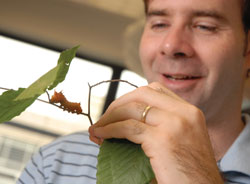
Historic $10 Million Gift Will Transform the Charles E. Smith Center | Two Projects Aim to Improve Global Health | Noted Alumni Inducted into Sports Executives Hall of Fame | Gala Raises Funds for Cancer Programs | Joe McKeown: GW’s Winningest Coach | Above the Rim | $2.5 Million Gift Creates an Endowed Professorship in Hebrew Bible | GW Inaugurates Nationals Park With a Win | Faculty Focus | George Welcomes | New Technology Allows Rapid Cell Analysis | Students Branch Out With Eco Project | Two Discoveries Explain Scientific Remains | Rural Culture on the Edge | GW Launches Five-Year Plan to Address Affordability | At A Glance | A Faculty for Writing

Faculty Focus
A Curiosity for Creepy-Crawlers

Biology professor John Lill studies the diet and habitats of Washington’s native caterpillars.
Jessica McConnell
In the recesses of Bell Hall sit row upon row of plastic containers filled with caterpillars of all shapes, sizes, and colors. Some are as small as a fingertip, while others are as poisonous as a jellyfish. Some are as green as the leaves they feed on; others as brightly colored as a rainbow.
The lab is the domain of Assistant Professor of Biological Sciences John Lill. With the help of a four-year, $416,534 grant from the National Science Foundation, he is studying the diet and habitats of the Washington, D.C., area’s native caterpillars, also known as “slug caterpillars.”
Lill, who joined GW’s Biology Department from Washington University in St. Louis in 2002, says he always has been captivated by the complexities of the caterpillar diet. “The larvae of butterflies and moths, or caterpillars, are among the most diverse and the most abundant insect herbivores on the planet,” Lill says. “Their amazing diversity and intimate interactions with their host plants fascinate me. Caterpillars also are abundant in the temperate zone, common in forests, which are nice places to work, and fun to observe and rear in the laboratory—a combo which makes them very attractive!”
While summertime into early fall is peak season for the caterpillars, finding them is not easy. Lill and his team of GW student research assistants spend 12 to 14 hours each week combing the Patuxent Research Refuge in Laurel, Md., and the Little Bennett Regional Park in Clarksburg, Md., for four species of slug caterpillar: saddleback, spiny oak, yellow shouldered, and skiff moth.
Lill explains that slug caterpillars are “generalists,” meaning they feed on a wide variety of plant species with varying nutritional qualities. “The main thrust of the grant is to understand the dietary breadth of caterpillars and why they feed on so many species of plants,” Lill says. “We are trying to improve our understanding of which plants they feed on, and which predators eat the caterpillars.”
Lill says one hypothesis explaining caterpillars’ diverse appetite is that the plants with high nutritional value are often riddled with predators, such as wasps and parasites. To determine the “fitness” of the plants, Lill and his students place some caterpillars in small plastic “sleeve cages” that protect them from would-be predators, while leaving others unprotected on six different tree species to determine the survival rate. “Every week we open up the bag to see if the caterpillars have survived or not, and we measure them for growth,” Lill says. “We are looking to see if the best foods might be the most dangerous for the caterpillars.”
Another hypothesis is that a plant’s nutritional value and attraction to predators varies each year, causing caterpillars to adjust their diet accordingly. Lill believes a plant’s scent may change over time, which could lead a moth to lay its eggs on a different species of plant than the year before. “There’s a whole world of smell that we don’t understand very well,” Lill says. “But there’s a wealth of studies that show that the smell emitted by plants attracts enemies, and we think predators played a huge role in the evolution of these caterpillars.”
To conduct their study, Lill and his team must collect and rear thousands of caterpillars every summer. The work is very labor intensive, requiring them to search under leaves and trees for caterpillars as small as 2 millimeters. Once found, the caterpillars are stored in plastic containers in Bell Hall. Lill and his research assistants constantly check on the insects, replacing their food once a week, noting their growth, and recording the species of plant the caterpillar is eating. They use small paintbrushes to transport the stinging caterpillars from leaf to leaf.
As required by the NSF grant, Lill also is reaching out to local schools to teach students about insect evolution. Lill teaches three classes in the GW Department of Biology and says he feels strongly about bringing his classroom outside. “I really enjoy working with students in the field,” he says, “because I think that’s where learning really happens.”
—Julia Parmley
|